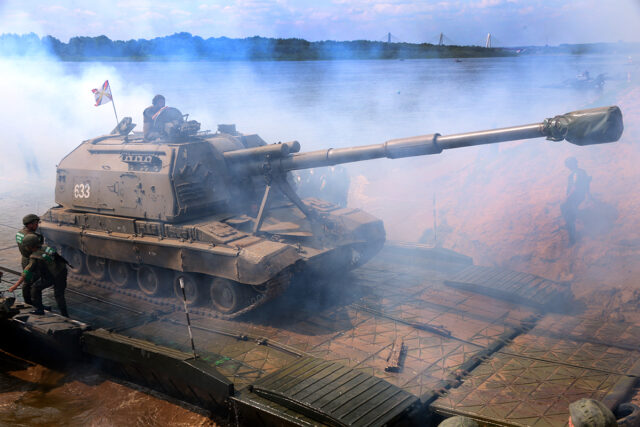
Jet Engines and Commercial Aviation: Key Indicators for Russian Arms Manufacturing
Publication: Eurasia Daily Monitor Volume: 20 Issue: 106
By:

Russia’s military industry continues to bolster efforts to increase arms production in the face of strangling Western sanctions. The results of these efforts have been doubtful considering the engagement of high-ranking officials in the administration of any single factory, their “manual mode” of management and massive organizational changes without clear reasons, as happened with the Russian artillery industry where reorganization took several months (RBC, April 18; Interfax, June 6; Scrf.gov.ru, June 15; Rostec.ru, June 28; Roscosmos.ru, June 29).
However, the lack of open and accurate information regarding production rates in Russia’s defense industry forces analysts to search for more data that will improve assessments of Russian arms manufacturing. In this way, the production statistics for commercial aircraft and engines, for which significant data is available in open sources, may be used as indicators of the aerospace industry as the most advanced part of the Russian military-industrial complex.
At the moment, the manufacture of commercial aircraft is facing skyrocketing costs. The price of manufacturing MC-21s, the Russian counterpart of the Boeing 737 and Airbus A320/321, of which first deliveries are scheduled for 2024, has increased from 3.2 billion rubles ($43 million) for delivery in 2024–2026 to somewhere between 4.3 billion and 4.6 billion rubles ($50 million–$54 million) for delivery in 2028–2030. This is actually higher than the price of the American and European aircraft of the same type, which contradicts the recently declared plans. The amount of MC-21s planned to be supplied by 2030 is 270 aircraft, with the largest portion scheduled for 2027–2030 when annual production is set to achieve 72 aircraft (Ixbt.com, April 7; TASS, April 25; Kommersant, June 29).
However, the problem here is that the state-sponsored program for MC-21 production projected an average annual production rate of 36 aircraft, with a peak option of 45 planes (Rossiyskaya gazeta, December 15, 2020). Moreover, almost half of these aircraft were meant to receive American-made PW1400G engines, while the other half were planned to receive Russian-made PD-14 engines. The development and production of this particular engine is also state-sponsored, and the originally planned annual production rate was 50 engines. Yet, according to the current plans, annual production of PD-14s must reach 160. Such a massive increase is hardly possible, especially when considering that only 12 engines were going to be produced in 2024 (59.ru, May 30, 2017; TASS, June 22, 2022; Ixbt.com, April 7).
The current manufacturing rate of Tu-214 aircraft is also far from reaching Russia’s needs. The annual production rate is planned to be increased from one to ten aircraft in 2025–2026 and to 20 aircraft in 2027–2030. For this purpose, the Russian government and state-owned corporation Rostec need to invest 83 billion rubles (about $1 billion), with the import substitution of this Soviet-era aircraft only being completed by the end of 2024 (Interfax, June 22; Ixbt.com, June 24). The price of Tu-214s was reported as similar to the price of MC-21s at the beginning of 2023, almost 3.2 billion rubles ($43 million); it will likely also surpass the manufacturing price of Boeing 737 and Airbus A320/321 aircraft in the foreseeable future, which will lead to more losses (Expert.ru, January 14).
The program to upgrade the TV7-117 engine (TV7-117-ST-02 version), which is focused on helicopters and the new Il-114-300 turboprop cargo aircraft, is another example of the dysfunction in Russian arms manufacturing. The production plan for 2023–2024 aims for six new engines for Il-114-300 aircraft per year, and the projected annual production rate of the TV7-117-ST-02 version is 20 to 50 engines for 2025–2027. However, the total production rate of the whole TV7-117 family of engines is supposed to be 100 per year by 2028–2030 (Aviaport.ru, June 29). Thus, it is hard to say whether Russia will be able to achieve this planned production rate for the new engines if there are problems with manufacturing the previous generation of TV3-117 engines, which are used on many Russian helicopter models, including the combat-ready ones. For example, in 2021, Russia produced about 300 TV3-117s, but production was dependent on smuggling supplies from Ukraine. The plan for 2023 is 500 engines; however, the main operator of Russian-made commercial helicopters has already declared a severe storage in related parts (TASS, March 31, 2022; Interfax, May 18).
All this means that the significant increase in production rates within the Russian aircraft industry will inevitably mean enormous cost increases even if production is based on well-known technologies, components and industrial equipment. In addition, the planned switch to new generations of engines, aircraft or other systems will mean a decrease in production rates but additional increases in costs. Consequently, the plan to increase domestic arms production in Russia will likely see similar cost increases and challenges, despite any self-congratulatory statements from Kremlin officials.



